Lithium-Ion Battery Aging Analysis of an Electric Vehicle Fleet Using a Tailored Neural Network Structure
Abstract
:Featured Application
Abstract
1. Introduction
2. Contributions
- Fleet managers may use the information to optimize task planning. Furthermore, predictive maintenance can be utilized.
- Cell manufacturers gain information on how the lifetime under real-world conditions compares to the rapid aging tests which are commonly performed.
- Battery manufactures can supervise the compliance of warranty conditions. Warranty extensions may be defined and sold subject to specific usage scenarios.
- Due to the holistic analysis of fleet vehicles, anomalies can be observed. This can help detecting critical states and may prevent battery accidents.
3. Research Data
3.1. Data Description
- All vehicles operate the same NMC battery type. The difference in energy content of the batteries emerges only from the different number of parallel strings. This warrants comparability of the data.
- The buses use different charging strategies. Whereas some are only charged in the depot at the end of the day, others are charged opportunely, i.e., they are also recharged several times during a shift at fast charging stations (see Figure 1). The charging strategies can typically be characterized as follows:
- ◦
- Depot: several hours charging duration, C-rate of less than 0.2 C,
- ◦
- Opportunity: less than 15 min charging duration, C-rate of more than 1 C.
- The vehicles, especially the buses, generate enough monthly energy throughput to ensure a detectable battery aging soon, see Figure 2.
- We can derive the necessary input data from the logged battery signals with the required sample rate, accuracy and resolution.
3.2. Data Selection
4. Neural Network Model and Training
4.1. Current State of Research
- (1)
- Model-based approaches often use algebraic or differential equations to model the physical and/or electrochemical behavior of battery degradation. In general, they are very accurate, but complex and require special measuring equipment to gather the necessary information.
- (2)
- Data-driven approaches treat the mechanisms within the battery as a black box. Instead, they use historical data to build a mathematical model and evaluate the aging state by statistical or ML methods. They are very flexible, only have to satisfy a few assumptions, but need a lot of data to accurately generate the model.
- (3)
- Hybrid approaches exploit the respective assets of both model-based and data-driven approaches.
4.2. Fleet Model Structure
- Capacity tests cannot be carried out during the conventional operation of a vehicle fleet. The training of the fleet model is thus restricted to the signals measured by the battery monitoring system. We therefore fit the model to the measured voltage and use capacity estimations (for instance from dedicated charging with small currents) only for validation purposes.
- In contrast to existing approaches, we want to create a model that includes multiple devices. Moreover, information transfer between the fleet vehicles should be enabled.
- It should be possible to incorporate existing domain knowledge (for instance open circuit voltage (OCV) curves) and recognized constraints (only increasing resistances/decreasing capacities) into the model.
- The model should be extendible, such that we can couple it with an aging model that not only describes the battery aging of the fleet vehicles but also determines aging stress factors and predicts the aging until EOL.
- We want to perform virtual experiments to analyze the battery’s SOH according to different usage scenarios. The SOH is typically defined as the relative capacity of the battery; in some cases, resistance is also considered. The impact of both parameters on aging strongly depends on the conducted operation. So, in real applications a scenario-based SOH definition might be more relevant, e.g., for the feasibility of a specific usage. This approach leads to a natural weighting of these aging parameters. This can be beneficial for route planning etc.
- The model should be scalable, i.e., it should also work with larger fleets.
- core battery model: The structure of this core battery model is shown in Figure 6. It consists of a part which describes the OCV as a function of the SOC and a part modeling the overpotential. Using temperature, current and SOC information as well as the actual SOH (given by the scaling factors and ), the battery voltage is predicted. Dynamic effects are taken into account by using multiple low-pass time filters of the current signal. Thus, previous current values are considered. This is inspired by ECMs where this is done using RC-elements. Recurrent neural networks are an alternative implementation, especially with Long Short-Term Memory. Although they are widely employed, our approach reduces the parametrization effort and is more robust as is shown in [26].
- All vehicles of the fleet share this core battery model. Since the neural network is fed with all vehicles, it simulates the average battery behavior. This permits information transfer between different devices, e.g., if some vehicles are only operated at small SOC (or current or temperature) ranges, training the model with the remaining devices enables the extrapolation to a wider SOC (or current or temperature) range.
- aging parameter database: This model part contains the aging information of each vehicle in the fleet and outputs the SOH based on the device’s , the lifetime as well as the total charge throughput. To calculate the SOH, vehicle-specific calendric and cyclic aging rates are stored. An advantage is the easy detection of peculiarly aged batteries by investigating the SOH scaling factors (see Section 4.3).
- soc0 model: Since the SOC given by the BMS is no direct measurement and error-prone, we do not use this signal. Instead, we calculate our own SOC signal. After coulomb counting, we recalibrate the signal with adjusting factors to compensate for measurement errors and data gaps.
4.3. Training Process
- usage of Adam optimization algorithm, which adjusts the learning rate based on first and second moments of the estimated gradients,
- initialization methods for all submodels:
- ◦
- using laboratory cell tests of similar NMC cells for the OCV curve,
- ◦
- pretraining of the overpotential model with ohmic resistance,
- ◦
- estimation of the initial SOC of each section from initial voltage and OCV curve,
- iterative and temporary fixing of some of the model weights,
- early stopping of the training based on validation points (see previous section),
- in the future: detection and elimination of anomalous sections (due to measurement or data transmission errors).
5. Findings
5.1. Model Validation
5.2. Transfer Learning
- We use training data from all devices and evaluate the model on validation sections of a given device.
- Only training data from the device selected in approach 1. is used and evaluated on the same validation sections.
- We compare the results of 1. and 2. for each validation section.
5.3. SOH Investigation
6. Conclusions
7. Outlook
Author Contributions
Funding
Informed Consent Statement
Data Availability Statement
Conflicts of Interest
References
- BMBF. Battnutzung-Cluster. 2022. Available online: https://www.battnutzung-cluster.de/de/projekte/febal/ (accessed on 29 March 2023).
- Hu, X.; Xu, L.; Lin, X.; Pecht, M. Battery Lifetime Prognostics. Joule 2020, 4, 310–346. [Google Scholar] [CrossRef]
- Zhao, J.; Burke, A.F. Electric Vehicle Batteries: Status and Perspectives of Data-Driven Diagnosis and Prognosis. Batteries 2022, 8, 142. [Google Scholar] [CrossRef]
- Doyle, M.; Fuller, T.F.; Newman, J. Modeling of galvanostatic charge and discharge of the lithium/polymer/insertion cell. J. Electrochem. Soc. 1993, 140, 1526. [Google Scholar] [CrossRef]
- Xia, L.; Najafi, E.; Bergveld, H.; Donkers, M. A Computationally Efficient Implementation of an Electrochemistry-Based Model for Lithium-Ion Batteries. Int. Fed. Autom. Control 2017, 50, 2169–2174. [Google Scholar]
- Safari, M.; Morcrette, M.; Teyssot, A.; Delacourt, C. Multimodal Physics-Based Aging Model for Life Prediction of Li-Ion Batteries. J. Electrochem. Soc. 2008, 156, 145–153. [Google Scholar] [CrossRef]
- Gopalakrishnan, K.; Offer, G.J. A Composite Single Particle Lithium-ion Battery Model through System Identification. IEEE Trans. Control Syst. Technol. 2021, 30, 1–13. [Google Scholar] [CrossRef]
- Rechkemmer, S.K.; Czech, B.; Zang, X.; Zhang, W.; Sawodny, O. Adaptability of Li-Ion Single Particle Model for Lifetime Simulation using LFP and LMO cells. In Proceedings of the Conference on Control Technology and Applications, Copenhagen, Denmark, 21–24 August 2018. [Google Scholar]
- Nascimento, R.G.; Corbetta, M.; Kulkarni, C.S.; Viana, F.A. Li-ion Battery Aging with Hybrid Physics-Informed Neural Networks and Fleet-wide Data. In Proceedings of the Annual Conference of the Prognostics and Health Management Society, Online, 29 November–2 December 2021. [Google Scholar]
- Ng, M.F.; Zhao, J.; Yan, Q.; Conduit, G.J.; Seh, Z.W. Predicting the state of charge and health of batteries using data-driven machine learning. Nat. Mach. Intell. 2020, 2, 167–170. [Google Scholar] [CrossRef] [Green Version]
- Plett, G.L. Extended Kalman filtering for battery management systems of LiPB-based HEV battery packs Part 3. State and parameter estimation. J. Power Sources 2004, 134, 277–292. [Google Scholar] [CrossRef]
- Zhao, S.; Duncan, S.R.; Howey, D.A. Observability analysis and state estimation of lithium-ionbatteries in the presence of sensor biases. IEEE Trans. Control Syst. Technol. 2015, 25, 326–333. [Google Scholar] [CrossRef] [Green Version]
- Meng, J.; Boukhnifer, M.; Diallo, D.; Wang, T. A New Cascaded Framework for Lithium-Ion Battery State and Parameter Estimation. Appl. Sci. 2020, 10, 1009. [Google Scholar] [CrossRef] [Green Version]
- Campestrini, C. Practical Feasibility of Kalman Filters for the State Estimation of Lithium-Ion Batteries; Technische Universität München: Munich, Germany, 2017. [Google Scholar]
- Andre, D.; Nuhic, A.; Soczka-Guth, T.; Sauer, D.U. Comparative study of a structured neural network and an extended Kalman filter for state of health determination of lithium-ion batteries in hybrid electric vehicles. Eng. Appl. Artif. Intell. 2013, 26, 951–961. [Google Scholar] [CrossRef]
- Zhao, R.; Kollmeyer, P.J.; Lorenz, R.D.; Jahns, T.M. A Compact Methodology Via a Recurrent Neural Network for Accurate Equivalent Circuit Type Modeling of Lithium-Ion Batteries. IEEE Trans. Ind. Appl. 2019, 55, 1922–1931. [Google Scholar] [CrossRef]
- Zhang, Y.; Xiong, R.; He, H.; Pecht, M.G. Long Short-Term Memory Recurrent Neural Network for Remaining Useful Life Prediction of Lithium-Ion Batteries. IEEE Trans. Veh. Technol. 2018, 67, 5695–5705. [Google Scholar] [CrossRef]
- Yang, F.; Li, W.; Li, C.; Miao, Q. State-of-charge estimation of lithium-ion batteries based on gated recurrent neural network. Energy 2019, 175, 66–75. [Google Scholar] [CrossRef]
- Savargaonkar, M.; Chehade, A.; Shi, Z.; Hussein, A.A. A Cycle-based Recurrent Neural Network for State-of-Charge Estimation of Li-ion Battery Cells. In Proceedings of the IEEE Transportation Electrification Conference & Expo (ITEC), Chicago, IL, USA, 23–26 June 2020; pp. 584–587. [Google Scholar]
- Hong, J.; Wang, Z.; Chen, W.; Wang, L.Y.; Qu, C. Online joint-prediction of multi-forward-step battery SOC using LSTM neural networks and multiple linear regression for real-world electric vehicles. J. Energy Storage 2020, 30, 101459. [Google Scholar] [CrossRef]
- Jiménez-Bermejo, D.; Fraile-Ardanuy, J.; Castaño-Solis, S.; Merino, J.; Álvaro-Hermana, R. Using Dynamic Neural Networks for Battery State of Charge Estimation in Electric Vehicles. Procedia Comput. Sci. 2018, 130, 533–540. [Google Scholar] [CrossRef]
- Xu, N.; Xie, Y.; Liu, Q.; Yue, F.; Zhao, D. A Data-Driven Approach to State of Health Estimation and Prediction for a Lithium-Ion Battery Pack of Electric Buses Based on Real-World Data. Sensors 2022, 22, 5762. [Google Scholar] [CrossRef] [PubMed]
- Li, K.; Zhou, P.; Lu, Y.; Han, X.; Li, X.; Zheng, Y. Battery life estimation based on cloud data for electric vehicles. J. Power Sources 2020, 468, 228192. [Google Scholar] [CrossRef]
- She, C.; Wang, Z.; Sun, F.; Liu, P.; Zhang, L. Battery Aging Assessment for Real-World Electric Buses Based on Incremental Capacity Analysis and Radial Basis Function Neural Network. IEEE Trans. Ind. Inform. 2020, 16, 3345–3354. [Google Scholar] [CrossRef]
- Li, W.; Chen, J.; Quade, K.; Luder, D.; Gong, J.; Sauer, D.U. Battery degradation diagnosis with field data, impedance-based modeling and artificial intelligence. Energy Storage Mater. 2022, 53, 391–403. [Google Scholar] [CrossRef]
- Heinrich, F.; Lehmann, T.; Jonas, K.; Pruckner, M.; Bäker, B.; Unger, A. Data Driven Approach for Battery State Estimation based on Neural Networks. In Proceedings of the 14. Tagung—Diagnose in Mechatronischen Fahrzeugsystemen, Dresden, Germany, 18–19 May 2021. [Google Scholar]
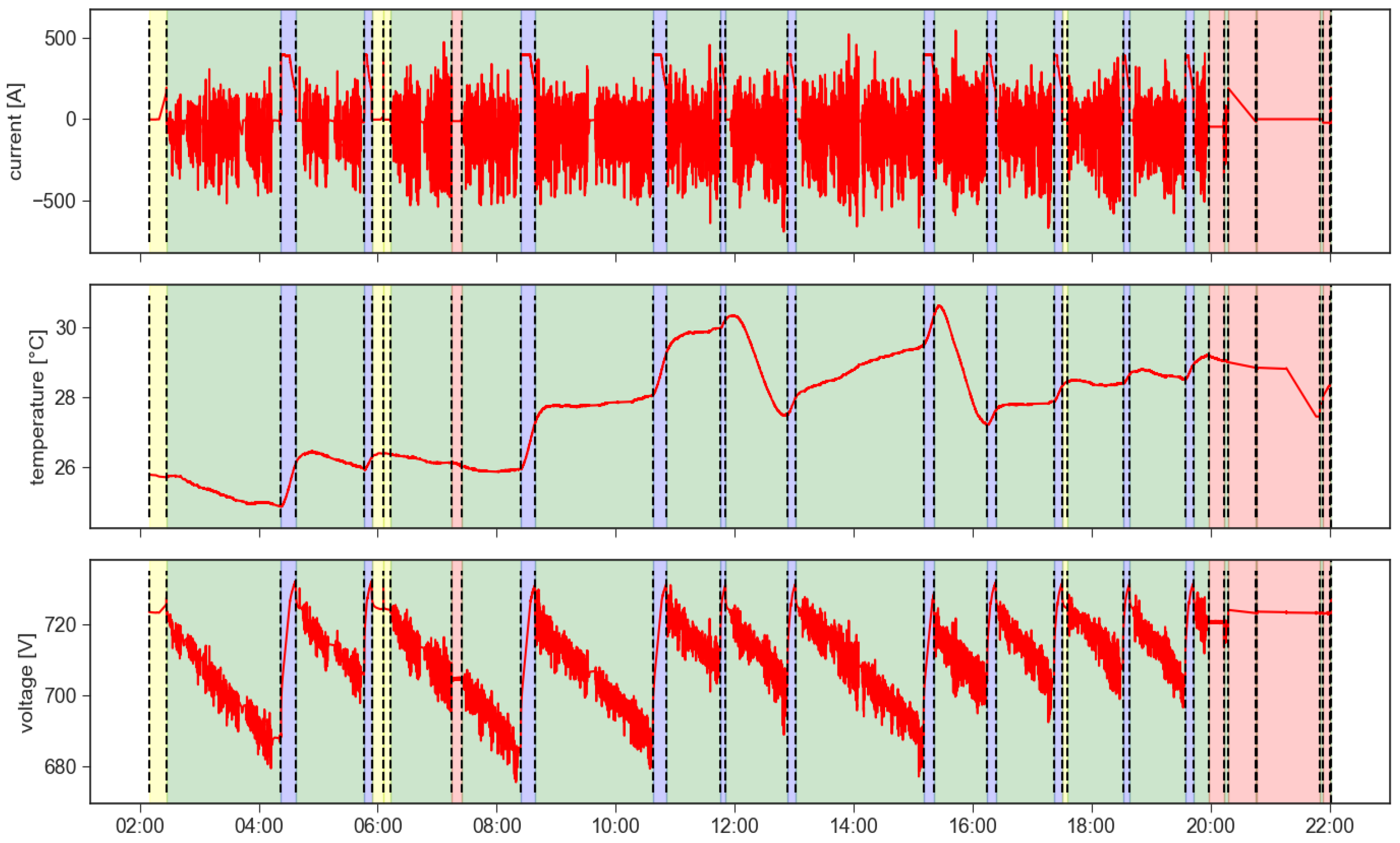
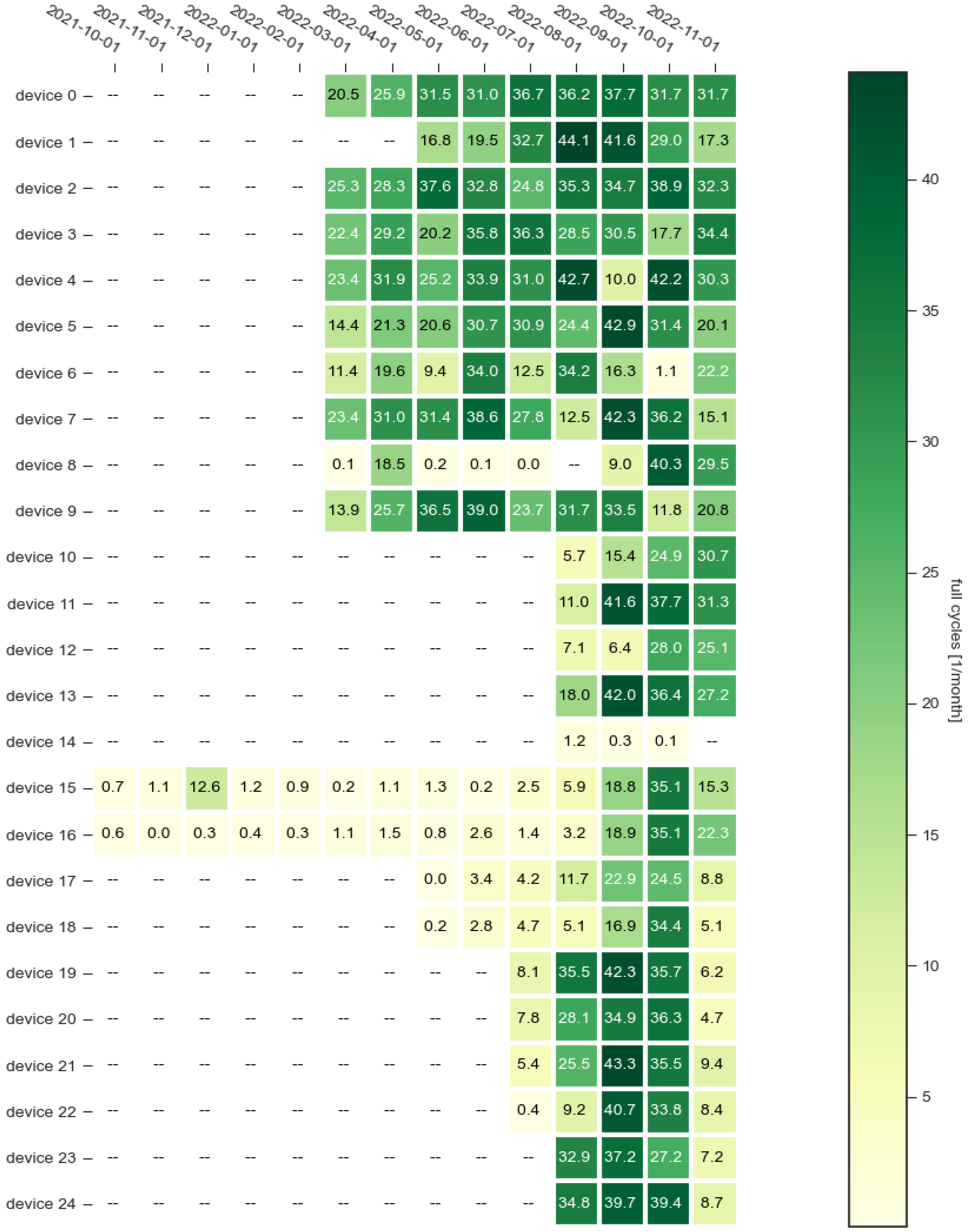
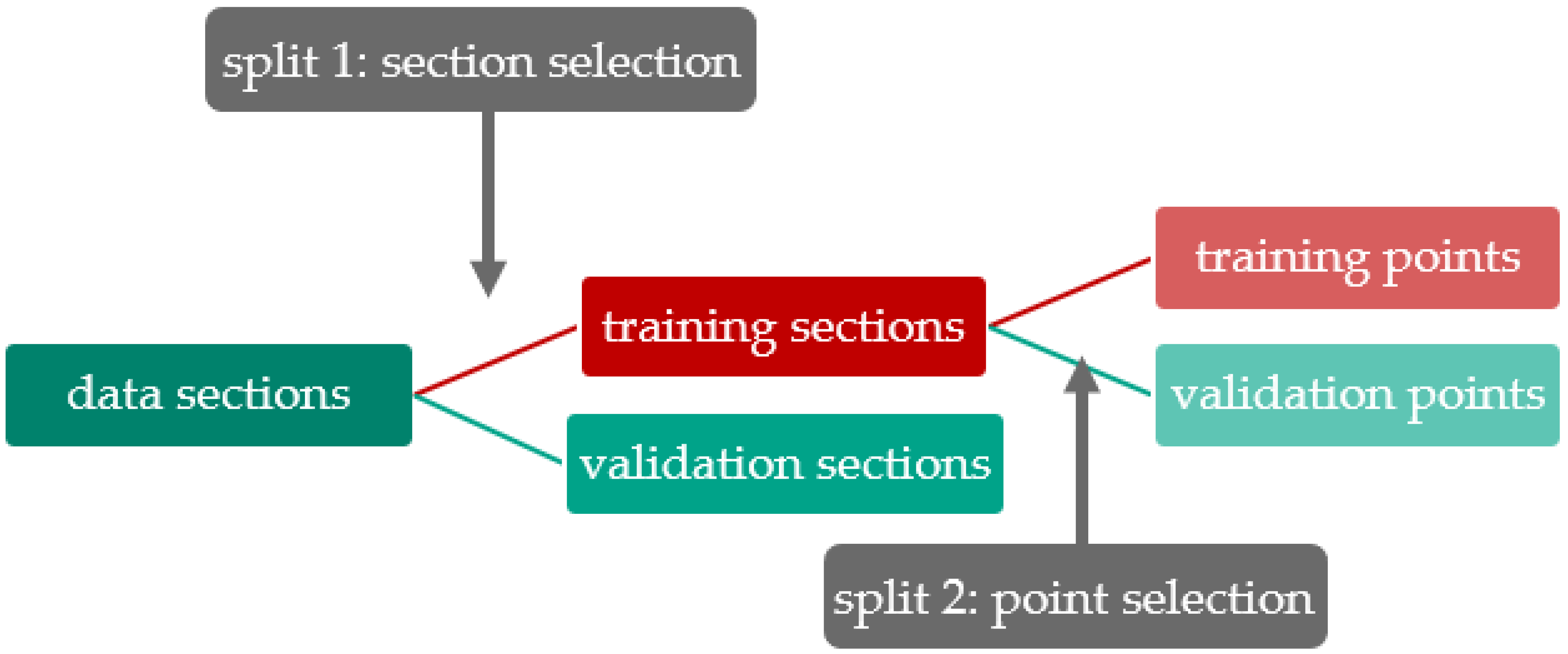
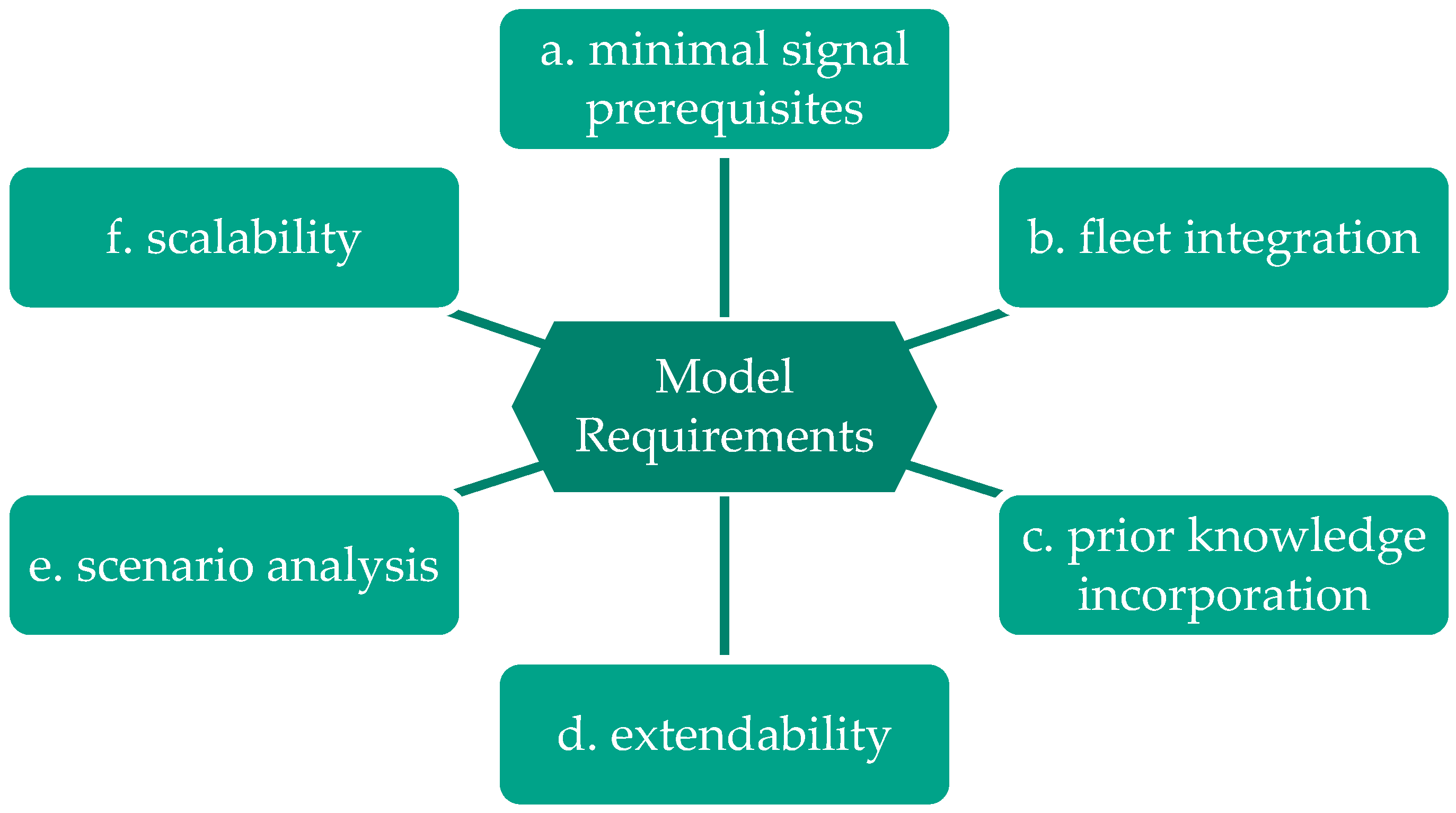
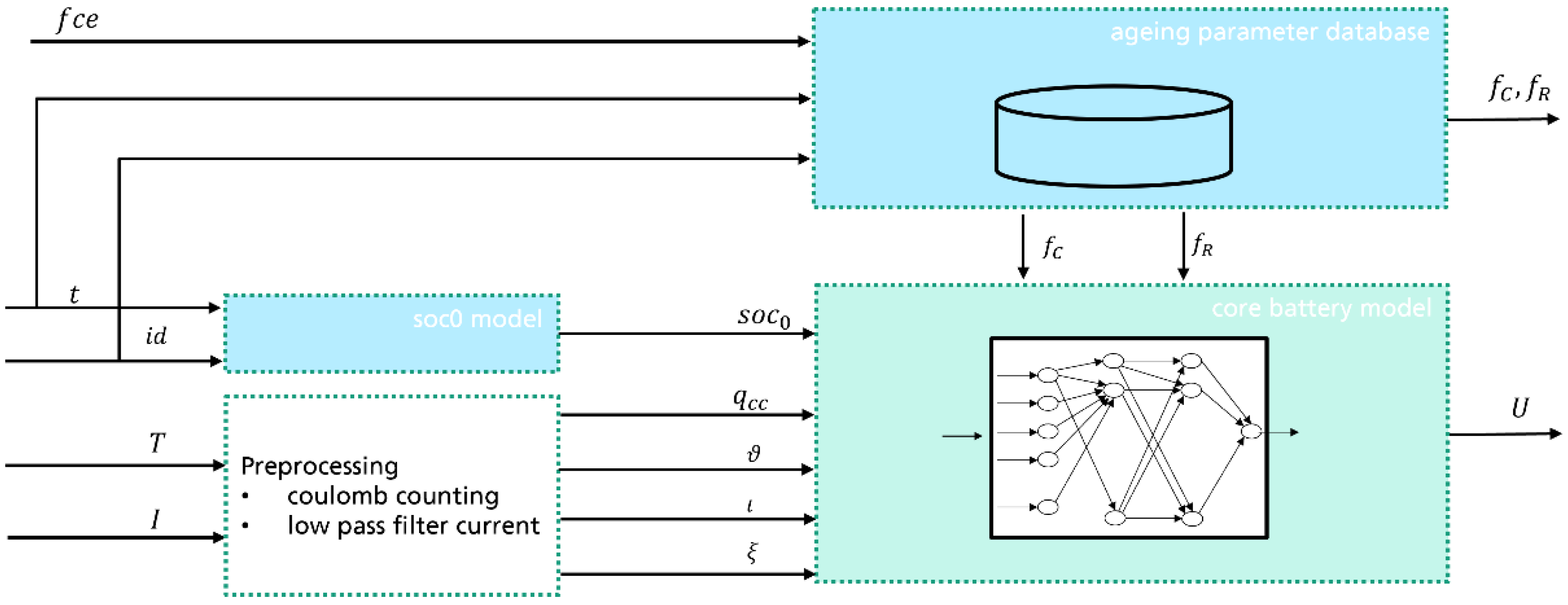

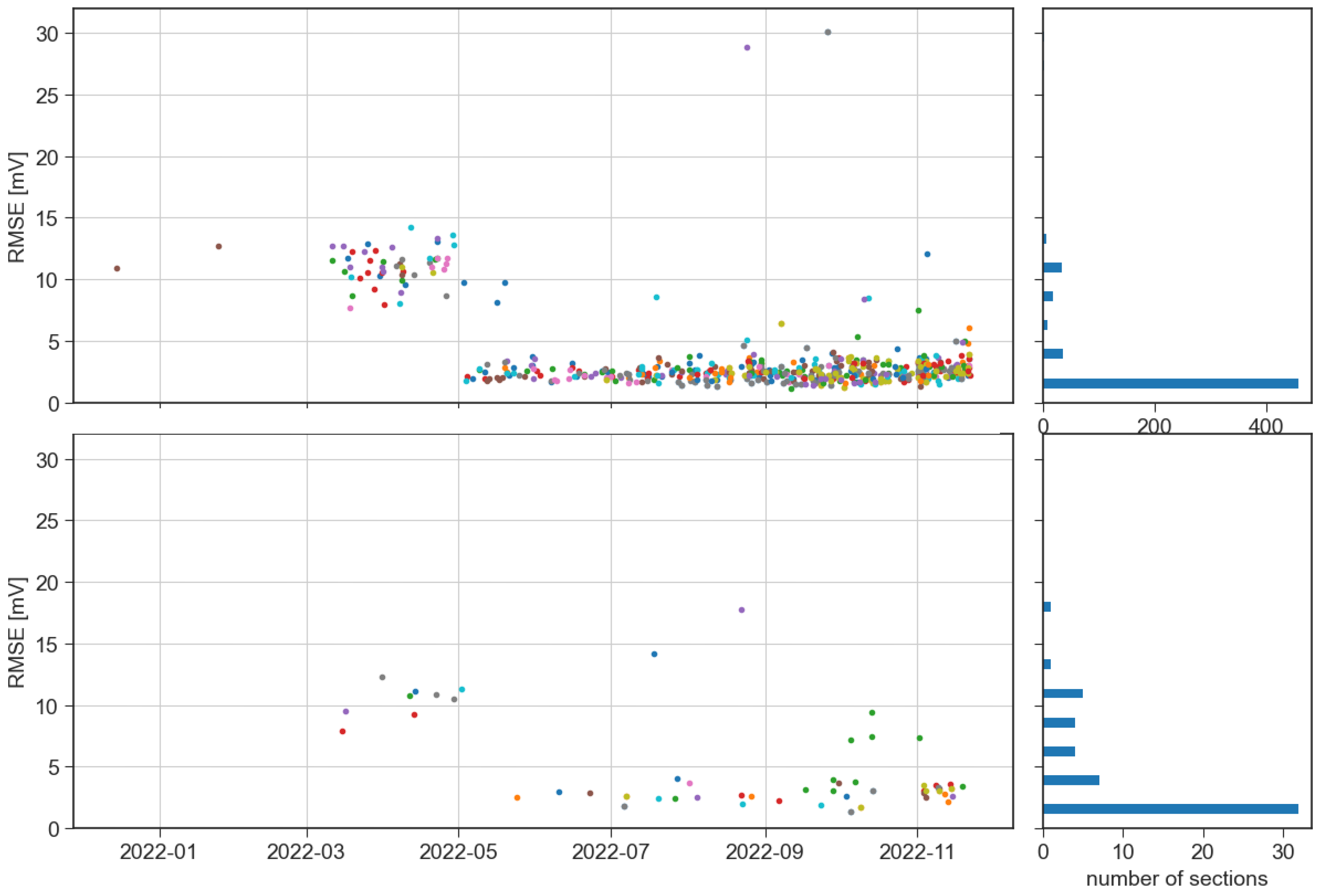

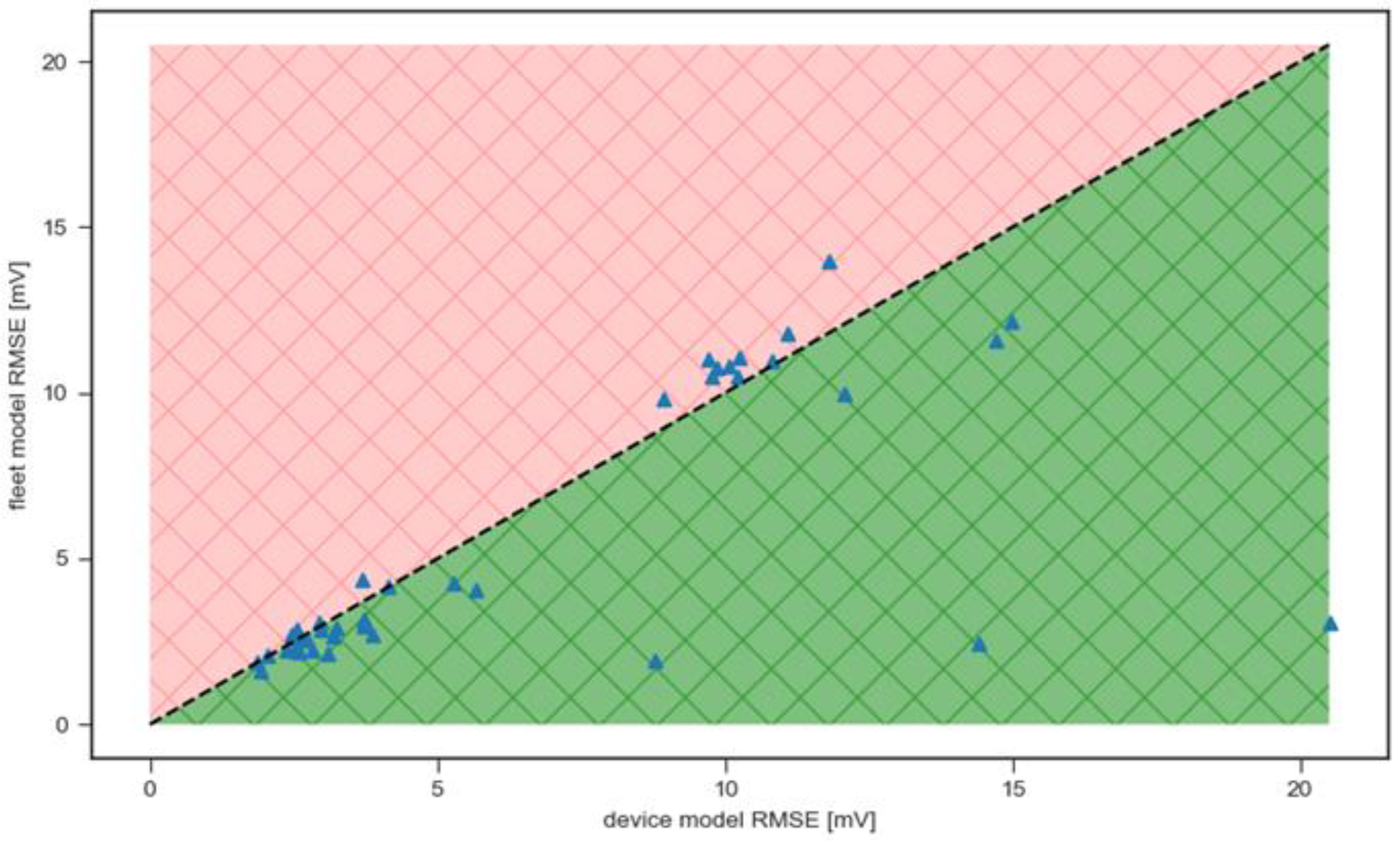
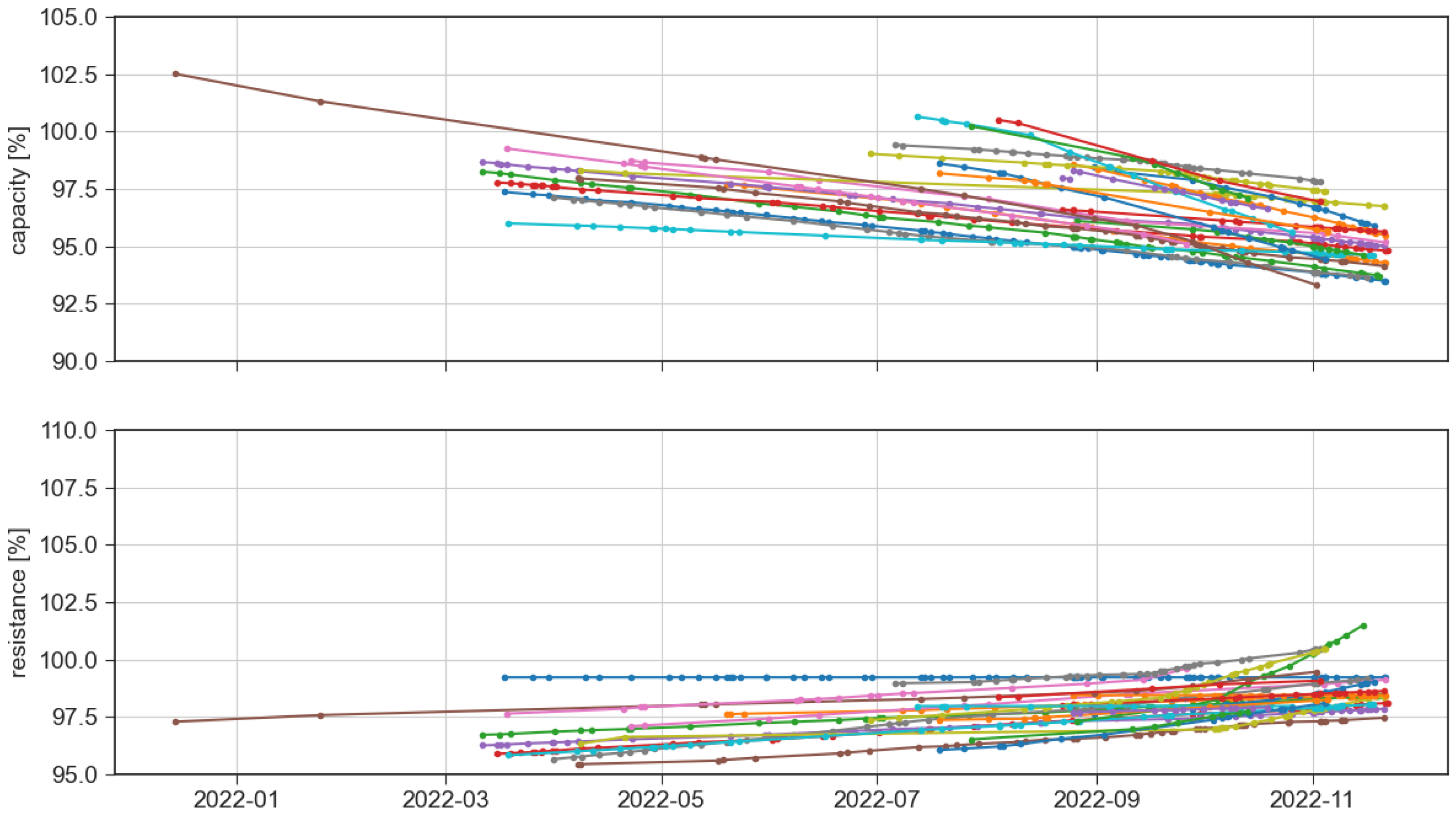
| # | Type (Num.) | Battery | Charging Strategy | Monthly Full Equiv. Cycles | Logging Start between |
|---|---|---|---|---|---|
| 1 | Car (19) | NMC, 36 kWh | Depot | 1.0–4.5 | 02.2021–06.2021 |
| 2 | Bus (>15) | NMC V1, 240–330 kWh | Opportunity, Depot | 15.0–50.0 | 11.2021–03.2022 |
| 3 | Bus (25) | NMC V2, 240–330 kWh | Opportunity, Depot | 15.0–45.0 | 11.2021–11.2022 |
| Inputs/Outputs | Description | Symbol | Unit |
|---|---|---|---|
| core battery model | |||
| current | Current flowing into the battery. Normalized by nominal capacity . | ||
| coulomb_counting | Normalized integrated current. | ||
| low-pass current | Time-filtered current. Since multiple time constants are used, this is a vector of length with one value for each time constant . Time constants are chosen according to the typical usage scenario as well as voltage relaxation times. | ||
| temperature | Temperature as measured by the BMS. This is usually a mean temperature of several sensors built into the battery pack. | °C | |
| voltage | estimated mean cell voltage | V | |
| aging parameter database | |||
| time | Lifetime or rather time since begin of logging. Used to account for calendric aging effects. | y | |
| device-id | Identification number for vehicle | ||
| full cycles | Charge throughput of device normalized by nominal capacity | ||
| relative capacity | estimated normalized capacity | ||
| relative resistance | estimated normalized resistance | ||
| soc0 model | |||
| time | same as above | ||
| device-id | same as above | ||
| initial SOC | estimated SOC at begin of section. Used to adjust the coulomb counting signal. | ||
Disclaimer/Publisher’s Note: The statements, opinions and data contained in all publications are solely those of the individual author(s) and contributor(s) and not of MDPI and/or the editor(s). MDPI and/or the editor(s) disclaim responsibility for any injury to people or property resulting from any ideas, methods, instructions or products referred to in the content. |
© 2023 by the authors. Licensee MDPI, Basel, Switzerland. This article is an open access article distributed under the terms and conditions of the Creative Commons Attribution (CC BY) license (https://creativecommons.org/licenses/by/4.0/).
Share and Cite
Lehmann, T.; Weiß, F. Lithium-Ion Battery Aging Analysis of an Electric Vehicle Fleet Using a Tailored Neural Network Structure. Appl. Sci. 2023, 13, 4448. https://doi.org/10.3390/app13074448
Lehmann T, Weiß F. Lithium-Ion Battery Aging Analysis of an Electric Vehicle Fleet Using a Tailored Neural Network Structure. Applied Sciences. 2023; 13(7):4448. https://doi.org/10.3390/app13074448
Chicago/Turabian StyleLehmann, Thomas, and Frances Weiß. 2023. "Lithium-Ion Battery Aging Analysis of an Electric Vehicle Fleet Using a Tailored Neural Network Structure" Applied Sciences 13, no. 7: 4448. https://doi.org/10.3390/app13074448




